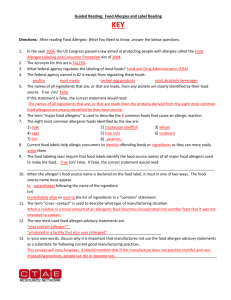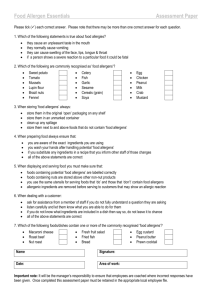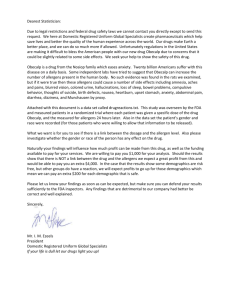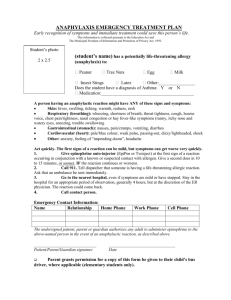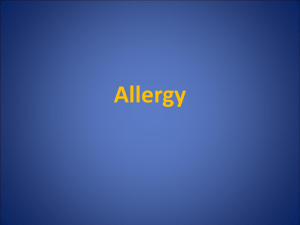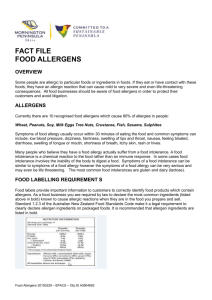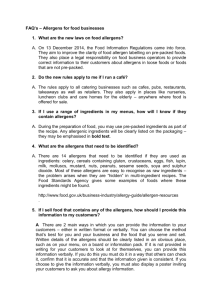Sample Anaphylaxis Awareness-Avoidance Strategies & Checklists
advertisement
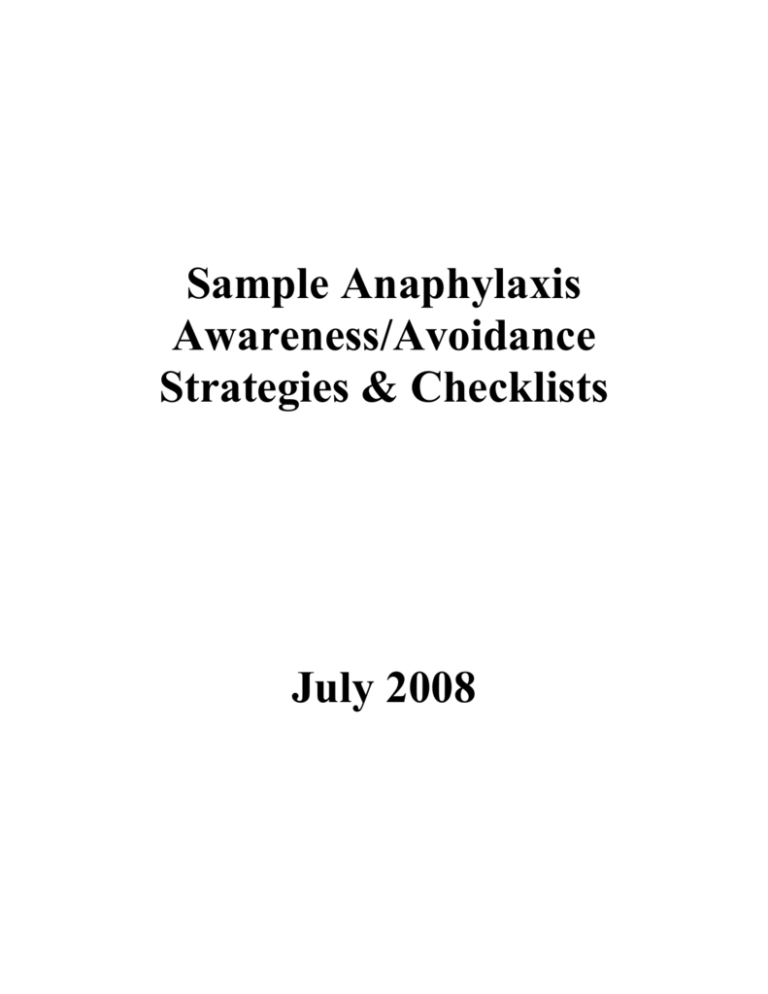
Sample Anaphylaxis Awareness/Avoidance Strategies & Checklists July 2008 Awareness and Avoidance Strategies Awareness Strategies o Awareness strategies are designed to make the school community (including staff, parents and students) aware that anaphylaxis exists and that certain foods are potential allergens. Primary goal is to decrease the amount of allergen that enters the classroom. o Allergen awareness regarding food product labels and ingredient lists: Unpackaged foods without clearly labelled ingredients can be a source of food allergens. It is important to read and understand ingredient lists and product labels. It is important to learn to recognize allergens when reading package labels Food product manufacturers may occasionally change their recipes or use different ingredients. Ingredients can vary between product size (i.e. a single serving size might have different ingredients that the multi-serving size of the same product). Product ingredients should be reviewed every time a product is purchased. Unpackaged foods without clearly labelled ingredients are not appropriate for children with food allergies. The Canadian Food Inspection Agency urges consumers with food allergy concerns who have questions about the ingredients in a product to contact the manufacturer of the product for more information. o Sample strategies: Letters to parents of other children, asking them to limit inclusion of pertinent allergens in their child’s snacks/lunches, sent out at beginning of the school year. Newsletter inserts requesting parents to consider “allergy aware” options (e.g. only send food products that are packaged, clearly labelled with ingredients, and do not contain pertinent allergens). Consider referring reader to the Health Canada Food Allergen –Consumer Fact sheets as relevant in the school resources on anaphylaxis: http://www.hc-sc.gc.ca/fn-an/securit/allerg/fa-aa/index_e.html. Can be a “Did You Know?” insert. Distribute school anaphylaxis plan to all families at beginning of the school year and publish reminders in school newsletters/bulletins. Utilize age appropriate educational resources (e.g. books, videos, games) addressing the topic of allergies. Work with student to educate his/her peer group about their allergy and how to provide emergency assistance in the event of a reaction (e.g. information on where the single dose auto-injector is located). Promote “food-free” celebrations for birthdays and other special occasions Avoidance Strategies Avoidance strategies are designed to help keep identified students safe from contact with allergens. Even trace amounts of food allergens can cause severe reactions from contact with the individual’s mouth or eye. Goal is to create an “allergy-aware” or “allergy-safe” environment; it would be almost impossible to guarantee an “allergy-free” environment. 2 Sample strategies: o Limit the amount of allergenic foods (e.g. peanuts, egg, milk1) that enter the classroom and school setting (e.g. special events). o Food-allergic individuals should always read food labels and avoid high risk foods such as bulk foods and foods which are known to often contain an allergenic substance. o Ensure that students wash their hands before and after eating – this is very important, and can make a big difference in reducing the transfer of allergens. o Provide a safe eating environment (without isolating the allergic student) o Surfaces such as toys, desks, and eating areas should be carefully and regularly cleaned. o Adult supervision of young children while eating is strongly recommended. o Discourage students from eating if they do not have access to their single dose autoinjector. o Individuals with food allergy should not trade or share food, food utensils, straws, or food containers. Identified students should place meals on a napkin or personal place mat. Young children should eat in the same location while at school (i.e. so schools can support safer environments for their anaphylactic students). o Parents can work closely with food service staff to support safer environments for their anaphylactic child. Food-allergic children should only eat food brought from home or food which has been approved by their parents. Food-allergic children should only try new foods at home, not at school. o Teach students to always ask about the preparation of foods when eating away from home. o Implement special precautions for food preparation. o The use of food in crafts/cooking classes may need to be modified or restricted depending on the allergies of the students. o Consider non-food items (e.g. stickers, pencils) for celebrations and rewards. If giving out food treats, they should be carefully checked for the particular allergens that anaphylactic students in the class have. Bulk food items should not be used as there are no ingredient lists and there is a risk of cross-contamination with food allergens. o Ingredients of food brought in for special events by the school community, served in school cafeterias, or provided by catering companies should be clearly identified. Parents of food-allergic children should be consulted when food is involved in class activities. Food should not be left out where young children with food allergy can help themselves. o All children should be encouraged to comply with a “no eating” rule during daily travel on school buses. o Reduce number of allergens in vending machines, and place vending machines in a central area. o Encourage eating in the cafeteria instead of halls and classrooms. o Discourage students from putting ends of pens and pencils into their mouths. 1 According to Dial-A-Dietitian, milk (and to a lesser extent egg) is a staple food for nearly all children and is a key food in a healthy diet. Procedures for management of egg or milk allergies in schools may be different from the procedures for managing of peanut allergies in schools. 3 o Garbage / recycling duty is high risk for allergic students. Anaphylactic students should not be picking up food wrappers or containers, etc. Assign them a library or other safe duty instead. o Bowls of peanuts/nuts in the staff room present potential risks to students with those allergies. Safer snack choices for allergy-aware schools might include popcorn, pretzels, vegetables or fruit. o Insect Stings Keep garbage cans covered with tightly fitting lids in outdoor play areas. Keep garbage cans away from where children have to line up to go into school. Consider restricting eating areas to designated locations inside the school building during daily routines, to allow for closer supervision and reduction of the prevalence of stinging insects. Have insect nests professionally removed. Encourage students with insect sting allergies to Stay away from areas where such insects gather – e.g. gardens, hedges, fruit trees and garbage cans. Drink from cups rather than beverage cans or bottles, and use a straw if drinking beverages outdoors. Avoid wearing bright colours and scented products. 4 Anaphylaxis Management Plan Checklist For________________________________ Date _______________________ The prevention plan is required to establish what measures can be taken to limit the child’s risk of exposure to an allergen to an appropriate level. The principal (or designate) in a meeting with the parent(s)/guardian(s) of the student with anaphylaxis will complete the Anaphylaxis Management Plan form. The management measures required will be communicated to staff and other parents (if necessary) by the principal (or designate). General Measures to be Discussed (Check Required Measures): □ Designate a safe eating area in the classroom that has good ventilation. □ Establish a hand-washing and desk-top washing routine before and after eating, particularly for younger students. □ Encourage the anaphylactic child to place waxed paper or a napkin on the desktop, remove only one item at a time from lunch kit and not to leave food unattended. □ Labelling stored food with the anaphylactic student's name. □ Discourage sharing of food, utensils, straws or containers. □ Discourage sharing of lipsticks and lip moisturizers. □ Limit the anaphylactic child to food brought from his or her home. □ If foods come from other homes into the classroom, remind parents of the anaphylactic child’s allergens and insist on ingredient lists. □ Consider measures for holidays and special celebrations (e.g. encourage food-free celebrations). □ Consider allergens in school activities (composting, gardening, school fund-raisers, vending machine options, yard clean-up, art projects, science projects, toys, seasonal activities, crafts, cooking). Describe specific plans: _______________________________________________________________________ _______________________________________________________________________ If the food allergen cannot be eliminated (such as dairy or egg) the above measures may be adequate. 5 Increased Avoidance Measures Create “allergen aware” areas of the school. If possible, avoid using the classroom of an anaphylactic child as a lunchroom. If the classroom must be used as a lunchroom, establish it as an “allergen-aware” area, using a cooperative approach with students and parents in the class. Develop strategies for identifying high-risk areas for anaphylactic students (such as the library, computer room, music room, gym and playground). Establish these as “allergenaware” areas. Discourage eating/drinking (other than water) in these areas. Describe “allergen aware” plan: _____________________________________________________________________________ _____________________________________________________________________________ □ It is recommended the parent share information in a meeting with other parents in the affected classroom, in consultation with the principal, to explain the seriousness of the situation. Describe plan _____________________________________________________________________________ _____________________________________________________________________________ □ Principal will send a letter to parents in the classroom at beginning of school year requesting they not send the offending food or foods that may contain that ingredient. Provide parents with a listing of ways the offending food may be found in ingredient labels. Describe plan _____________________________________________________________________________ _____________________________________________________________________________ □ Epinephrine Auto-injector (Single Dose) Management Anaphylactic children who have demonstrated maturity (as determined by the child’s parents) should carry at least one single dose auto-injector with them at all times and the school will keep additional single dose auto-injectors in a designated area, in case of an emergency. Ensure that single dose auto-injectors are stored in a safe (unlocked) but easily accessible location and that all staff has been informed of the single dose auto-injector locations. Describe plan _____________________________________________________________________________ _____________________________________________________________________________ 6

